
My generation of girls grew up sneaking around online, pretending to be older, pretending to be supernatural, in order to meet strangers — more important than the fleeting strangers, though, our Buddy List of names, was finding ourselves.
These days, 59 percent of people who visit worlds like Second Life have engaged in sexual activity there. 11 percent of users have either paid for or sold sex in their online world, and only 22 percent have never gotten rude with other avatars before. I mean, that’s what they said.
Two thirds of participants in a new, massive study of online games and virtual worlds have dated someone within a virtual world, while a quarter have gone on to form real-life dating relationships with their online partners. About the same amount visit virtual worlds together as a couples activity.
A massive study conducted in 2012 suggests that it’s mostly people my age and older who still play in “the Metaverse,” regularly visiting open, lawless virtual environments like Second Life. Gen Y-ers dominate the multiplayer game demographic — which, with all its rules and goals and leveling, is generally considered distinct from “virtual worlds,” according to the study, which was led by Georgia Tech/Northeastern’s Celia Pearce and her colleagues. Pearce says this study is the first of its kind in scale and depth.
There’s a big infographic of neat findings you can view here; the whole study is available to peruse here.
The featured image for this post on Offworld comes from Animations Rising, which sells custom looks and animations for Second Life avatars. 46 percent of virtual world users make some money from their online creations, and 28 percent support all their virtual world expenditures by selling online goods.
